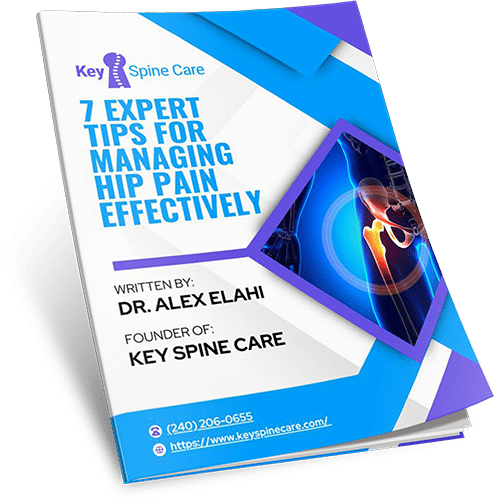
Hip Pain
Hip pain causes discomfort or soreness in the hip joint or surrounding area. While it’s usually felt around the outer part of the hip, it may also be experienced in the groin, thigh, or buttocks.
Hip pain can have a devastating impact on your daily life and can affect you in many ways, including:
- Difficulty with regular activities – the pain can make it difficult to walk, climb stairs, put on shoes and socks, and even get out of bed in the morning.
- Sleep disturbances – it can become difficult to achieve quality sleep and some people are woken up by it at night, leading to fatigue and mood swings.
- Social withdrawal – hip pain can lead to enforced isolation from social occasions as the discomfort you’re experiencing can make it almost impossible to socialize.
- Stop doing the activities you love – perhaps most consequential of all, hip pain can limit your participation in the hobbies and activities you love most. This can seriously impact the quality of your life, isolating you further.
To treat hip pain naturally, we will devise a bespoke treatment plan that includes targeted exercises, stretches, or changes to your daily habits to help you feel better and prevent future pain. The goal is to get your hip back in shape, improve how it functions, and ensure you feel good overall and empowered to live your life the way you want.
So, if you’re dealing with hip pain, our specialists could help you get out of pain and return to the hobbies and activities you love most.
Common questions
- Osteoarthritis: Wear and tear on the hip joint over time can lead to pain and stiffness.
- Bursitis: Inflammation of the fluid-filled sacs (bursae) around the hip joint can cause pain.
- Tendinitis: Inflammation of the tendons around the hip can result in pain, particularly with movement.
- Injuries or fractures: Falls or trauma can cause fractures or damage to the hip joint.
- Muscle strain: Overuse or strain of the muscles around the hip can lead to pain.
While many cases of hip pain can be managed with rest and conservative treatments, some signs suggest that the pain may be more serious and require medical attention:
- Pain that doesn’t improve with rest or over-the-counter medications.
- Pain that is severe or getting worse over time.
- Difficulty bearing weight or walking.
- Swelling, bruising, or deformity around the hip.
- Pain that radiates down the leg or into the groin area.
If any of these symptoms are present, it’s important to see a healthcare provider for a thorough evaluation.
At Key Spine Care, our CCSP® specialists design a personalized treatment plan tailored to the specific cause and severity of your hip pain. We take a conservative approach to care, focusing on therapies that promote your body’s natural healing abilities.
Treatment options for hip pain may include:
- McKenzie Method® of Mechanical Diagnosis and Therapy® (MDT)
- Dynamic neuromuscular stabilization (DNS)
- Joint manipulation
- Physical therapy
- Instrument assisted soft tissue mobilization (IASTM)
If further tests or specialist referrals are needed, the team at Key Spine Care will ensure you receive the right care. However, Key Spine Care offers the primary treatments necessary to alleviate your hip pain.
For a comprehensive approach to managing hip pain, call Key Spine Care or schedule an appointment online today.
Explore other services
Lumbar Spinal Stenosis
Can cause pain, burning, numbness, tingling and weakness of the legs, buttocks and lower back.
Read More
Physical Therapy
Anyone struggling with an injury, pain condition or disability can benefit from physical therapy.
Read More
Sciatica
Pain that starts in the lower back or buttocks and radiates into the back of the leg is caused by sciatica.
Read More
Our 3 Step Process to Alleviate Pain
At Key Spine Care, we focus on ACTIVE over passive treatment plans and proudly and exclusively only offer 1:1 care (e.g. no assistants or PTAs, just you and the doctor for the entire appointment, every time). We work together as a team to implement our shared plan to treat and prevent your symptoms.
After we have determined your individual diagnosis, we create a comprehensive and individualized plan to help you resume doing what you love - without the use of rest, pills, injections, or surgery!
After this stage, you will have:
1. Eliminated the source of the pain
2. Found pain-free postures
Request a Discovery Call
After we have determined your individual diagnosis, we create a comprehensive and individualized plan to help you resume doing what you love - without the use of rest, pills, injections, or surgery!
After this stage, you will have:
1. Eliminated the source of the pain
2. Found pain-free postures
While we love our 1:1 time with our patients, we also do NOT want you to be locked into a never-ending treatment plan of 2-3 visits per week for life! Most of our treatment plans are 12 visits or less as we prioritize teaching you how to:
- Eliminate the cause of the pain
- Find pain-free postures
- Develop healthy posture and movement patterns

